
-
Find the right food for your petTake this quiz to see which food may be the best for your furry friend.Find the right food for your petTake this quiz to see which food may be the best for your furry friend.Featured products
 Mature Adult Dog Food
Mature Adult Dog FoodHill's Science Plan Mature Adult Multipack Wet Dog Food with Chicken & Beef are complete premium pet foods for mature adult dogs from 7 years. Your dog will love these deliciously smooth and savoury minced loaves, formulated to deliver the appropriate amount of energy to support the needs of adult dogs.
Shop Now Puppy Food
Puppy FoodHill's Science Plan Puppy Multipack Wet Dog Food with Chicken & Beef are complete premium pet foods for growing puppies from weaning until 1 year old and for pregnant and nursing dogs. Your puppy will love these deliciously smooth and savoury minced loaves, formulated for balanced nutrition and overall health.
Shop Now Adult Wet Dog Food with Beef
Adult Wet Dog Food with BeefHill's Science Plan Adult Multipack Wet Dog Food with Chicken, Beef & Turkey are complete premium pet foods for adult dogs from 1 year. Your dog will love these deliciously smooth and savoury minced loaves, formulated for balanced nutrition and overall health.
Shop NowFeatured products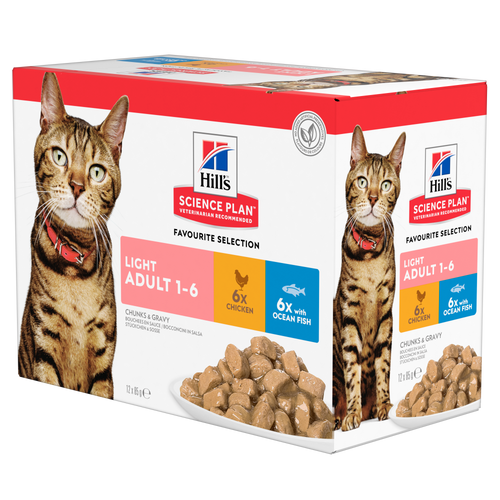 Light Adult Multipack Wet Cat Food with Chicken & Ocean Fish
Light Adult Multipack Wet Cat Food with Chicken & Ocean FishTender chicken chunks in gravy for cats, with L-carnitine and fewer calories for ideal weight management. Packed with high-quality protein, omega-6s, and vitamin E for shiny fur and healthy skin.
Shop Now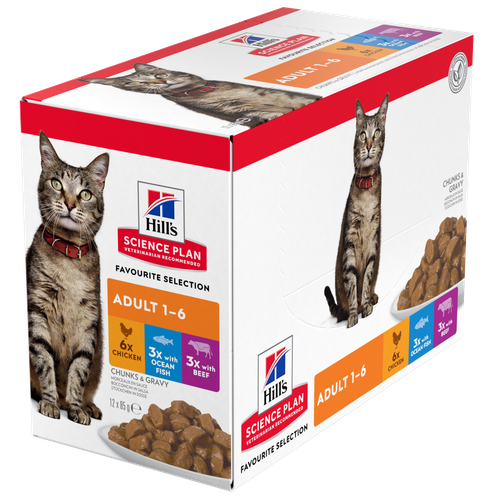 Adult Multipack Wet Cat Food with Beef, Ocean Fish & Chicken
Adult Multipack Wet Cat Food with Beef, Ocean Fish & ChickenTender chunks in gravy for cats, with high-quality protein to maintain lean muscle. With vitamin E and omega-3s & -6s for healthy skin and balanced minerals to support healthy vital organs.
Shop Now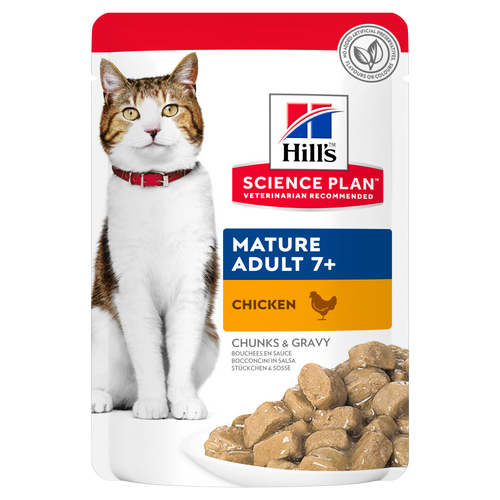 Mature Adult Wet Cat Food with Chicken
Mature Adult Wet Cat Food with Chicken
Tender chicken chunks in gravy for mature adult cats. Made with easy-to-digest ingredients, high-quality protein for lean muscle maintenance and antioxidant vitamins C+E for optimal health.
Shop Now -
Dog
- Dog Tips & Articles
-
Health Category
- Weight
- Food & Environmental Sensitivities
- Urinary
- Digestive
- Joint
- Kidney
-
Life Stage
- Puppy Nutrition
- Adult Nutrition
- Senior Nutrition
Cat- Cat Tips & Articles
-
Health Category
- Weight
- Skin & Food Sensitivities
- Urinary
- Digestive
- Kidney
-
Life Stage
- Kitten Nutrition
- Adult Nutrition
Featured articles The Right Diet For Your Pet
The Right Diet For Your PetIn people, the right diet is very important. If you are eating the wrong way for your metabolism, activity level, age and lifestyle you could end up with health issues.
Read More The Incredible Science Behind Your Pet's Microbiome
The Incredible Science Behind Your Pet's MicrobiomeLearn what your pet's microbiome is, how it contributes to your pet's gut and overall health, and why nutrition is important in maintaining healthy microbiomes.
Read More Show some love with wet foods: a great choice for pets with health issues
Show some love with wet foods: a great choice for pets with health issuesShow some love with wet foods: a great choice for pets with health issues.
Read More -


Cat dermatitis is a common condition that leads to itching, redness, and skin irritation. There are lots of things that can cause skin issues in cats, from fleas to food allergies, and many conditions share similar signs and symptoms. Because of this, skin diseases can be very challenging to diagnose. One such condition is cat allergic dermatitis. Prevention, where possible, and early diagnosis are important factors in cat dermatitis. Here, we’ll explain the common causes, signs and symptoms so that you can get your cat an accurate diagnosis and the best treatment.
Causes of cat allergic dermatitis
Cat allergic dermatitis refers to a skin condition caused by an allergen. Some of these allergies can also manifest themselves in other ways, such as vomiting and diarrhoea or respiratory signs. Just like humans, cats can get asthma associated with allergies. The four most common causes of allergies in cats are:
1. Flea allergy
Flea allergic dermatitis, or FAD, is very common in cats. Cats become allergic to the flea’s saliva, which is injected into the skin when the fleas feed. In sensitive cats, just one or two bites can cause severe irritation. In turn, this can lead to secondary infection, where bacteria from the skin are able to get into the cat’s system through self-inflicted scratch wounds in the skin. Fleas tend to prefer to stay around the tail base and head and neck, so if a flea allergy is the problem, you’ll often notice that signs such as hair loss and scabs are more concentrated in those areas.
It doesn’t take a serious flea infestation to cause signs in an allergic cat, so you may never actually see a flea on them. Fleas spend most of their time in the soft furnishings of the house and just hop on to feed, so you can’t rule out FAD if you don’t see them. A good way to spot the presence of fleas is to look for flea dirt in your cat’s fur. This is flea poo and is made up of digested blood. Comb your cat’s fur onto a white piece of kitchen roll and moisten any blackish specks you see with a drop of water. If it’s household dirt or mud, it won’t change colour, but flea dirt will leave a red stain as the blood soaks into the paper.
2. Atopy
Atopy is an allergy to things in the environment, such as dust mites, storage mites, pollens, grasses, trees, etc. Over time, cats can become allergic to one or several of these environmental allergens. In the case of seasonal allergens, like pollen, signs could only show at certain times of year, while other allergens, like dust, can cause problems year-round.
Atopic dermatitis tends to appear in young cats under the age of five, but it can occur in older cats, too.
Atopy tends to cause irritation around the head, neck and ears and the belly, flanks and legs. It is also a cause of otitis (inflamed ear canals). As well as skin symptoms, inhaled environmental allergens like pollens can also cause asthma in cats.
3. Food allergy or intolerance
Adverse food reactions (AFRs) in animals may be a “true” allergy, with an immune reaction to a certain protein, or an intolerance, which isn’t a true allergy. The most common food allergens in cats are chicken, dairy, fish and wheat. Food allergies will cause year-round skin symptoms, and you may also see gastrointestinal symptoms as well, such as vomiting, or more commonly, diarrhoea.
4. Contact allergies
Just as it sounds, some allergies occur when your cat comes into contact with something. This could be bedding washed in a certain washing powder or things like plastic food bowls. The signs of contact allergies will vary depending on where the contact is. Signs of irritation and hair loss round the chin are common with food bowl allergies, while other areas of the body may be affected by other chemicals or allergens depending on the point of contact.
Signs and symptoms of cat allergies
Cats are great at keeping their fur and skin in tip-top condition, so a healthy cat should have fur that is shiny, well-kept and lustrous. Signs of many skin diseases, including cat allergic dermatitis, can range from mild to severe and include:
Mild signs
Hair loss
Excessive grooming
Itching, scratching, licking or rubbing
Hair balls, because your cat is grooming more than usual and ingesting excess fur
Moderate signs
Flaky or scaly patches
Bad skin odour
Red patches, spots or pimples
Severe signs
Scabs, crusts or thickened skin
Eosinophilic granulomas. Eosinophils are a type of white blood cell involved in allergic reactions. In cats with severe allergies, you may see bright-red plaques or masses full of these cells on the skin. They often look very inflamed and angry.
Moist dermatitis or pyoderma. This is often secondary to other skin problems and due to the cat traumatising their own skin due to itchiness. Secondary bacterial infection sets in and this can be very problematic to treat. Cats get into a vicious cycle of itching and self-trauma.


Tasty Tips
How is cat allergic dermatitis diagnosed?
As we mentioned at the beginning, lots of skin diseases cause similar symptoms, so your vet will need to do tests to rule certain conditions in or out. These may include skin scrapes to look for parasites, hair plucks to check for fungal infections like ringworm, biopsies, food trials, blood tests and/or intradermal skin testing.
A flea allergy is usually diagnosed by the presence of the classic distribution of scabs and itchiness, and by the presence of flea dirt that we mentioned earlier.
Atopy is usually diagnosed after ruling other things out and doing a blood test or intradermal testing to find out what allergens are triggering your cat.
If a food allergy is suspected, your vet will want to do an elimination trial. Your cat will be given a special therapeutic food. This may be one that is hydrolysed, which means that the proteins are broken down into such small pieces that the body doesn’t recognise them as allergens. Alternatively, it may be a diet with a novel protein, such as duck or venison, that your cat has not eaten before. It is incredibly important that your cat eats only this food for the length of the trial, which may be up to 12 weeks.
As you can see, skin disease in cats needs a methodical approach when it comes to diagnosis. It can be time-consuming and costly, so be prepared and always consider pet insurance. Please be patient with your vet and their team while they try to get to the bottom of your cat’s problem.
Treatment and prevention of cat dermatitis
Treatment and prevention will vary depending on the cause of your cat’s allergic dermatitis. Also bear in mind that some cats can have more than one of these kinds of allergies so may need various strategies.
Flea allergy. Very strict flea control with effective products is usually a relatively easy fix for flea allergic dermatitis. If your cat has broken, inflamed skin due to excessive scratching, they may also be given a course of antibiotics and possibly some steroids to help stop the itching. Your vet may also recommend treating your house to get rid of any fleas that are hiding in the soft furnishings.
Using these effective flea treatments regularly, as recommended by your vet, should prevent fleas setting up house with you and keep your cat comfortable. Your vet may also recommend preventatively treating your house once or twice a year. Regular vacuuming also stimulates eggs to hatch and will allow the young fleas to be killed.Once you have identified your cat’s allergens, you can then have a specific ‘vaccine’ tailor-made for these allergens. This is called immunotherapy and it works by administering tiny doses to start with, then very gradually increasing them over months. The aim of this is to desensitise your cat to the allergens.
Obviously, anything you can do to reduce exposure is also useful in prevention of flare-ups, such as eliminating storage mites or getting rid of house plants that may be a trigger. Immunotherapy has a good response in around 70-80% of cats.Once you have finished your food elimination trial, you have a couple of options – your vet may suggest you reintroduce your cat to various foods, one at a time, to see what the trigger is, or you may decide to just stick with the therapeutic food if you obtain a great result.
In summary
It’s important to remember that some cats can have more than one skin issue going on at a time. And the underlying cause may be complicated by secondary infections and self-trauma. As we said, please be patient with your vet while they work through the process of getting to the bottom of your cat’s skin disease. Always complete courses of treatment that you are given. If you’re ever unsure, just ask your vet to clarify why they opted for that course of action.
Even if your cat is not allergic to food, your vet may recommend changing to a food that is designed to help cats with any skin disease. These foods help bolster the skin barrier function and keep it strong. They have essential fatty acids in them to keep skin healthy and reduce inflammation, along with added anti-oxidants to help reduce cell damage.
Many skin issues can have a great outcome with patience and good teamwork. Hopefully, your cat will soon be itch-free and back to their lustrous, beautiful selves.
FAQs
What are the first signs of cat dermatitis?
The earliest signs of cat dermatitis are usually overgrooming, scratching and hair loss.Is cat dermatitis contagious?
Allergic dermatitis is not contagious, but some skin problems caused by certain parasites can be contagious to other pets and humans. If you or your family have any skin changes, talk to both your vet and doctor.Can stress cause skin problems in cats?
Yes, a common cause of cat hair loss is stress-induced or psychogenic alopecia. You can read more about that here.What’s the best flea treatment for cats with skin allergies?
There are many flea treatments that are effective. Just follow your vet’s recommendation and never use products that do not say they are safe for cats.Can diet help improve my cat’s dermatitis?
In many cases, yes. Therapeutic diets for skin problems have certain ingredients which support skin health and function.
Reviewed by Dr. Hein Meyer, DVM, PhD, Dipl-ECVIM-CA and Dr. Emma Milne BVSc FRCVS.


One of our staff authors prepared this article for you
Related products
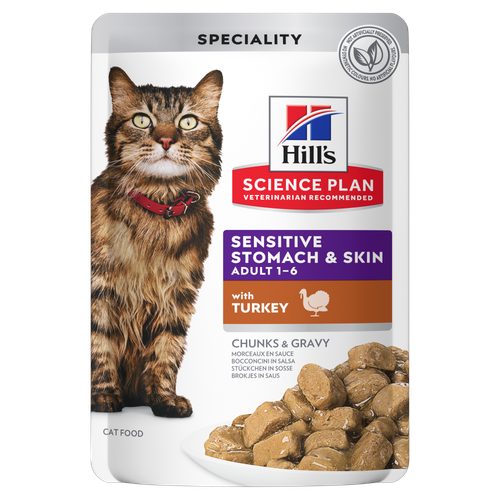
Hill's Science Plan Sensitive Stomach & Skin Adult Wet Cat Food with Turkey is a complete pet food for adult cats, aged 1–6 years. This highly digestible wet food comes in a pouch and supports healthy digestion, as well as nourishes skin and promotes a thick and lustrous coat.
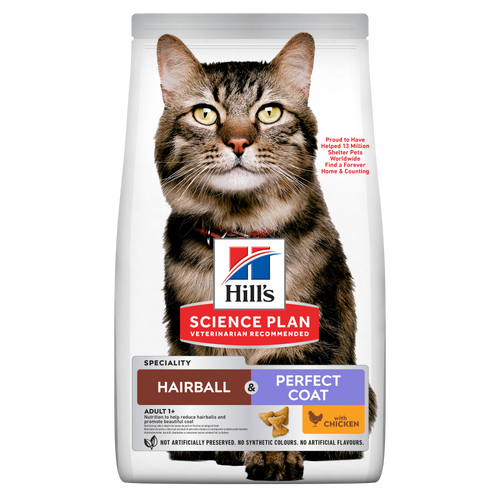
Hill's Science Plan Hairball & Perfect Coat Adult Cat Food with Chicken is formulated to effectively help avoid hairball formation in adult cats while promoting a beautiful coat. Thanks to its mix of essential omega-6 fatty acids, this food benefits the cat's skin and fur, keeping them healthy and shiny. Our Advanced Fibre Technology helps reduce hairballs by naturally promoting their passage through the gut. This food is formulated with high-quality protein for a perfectly balanced, great-tasting recipe.
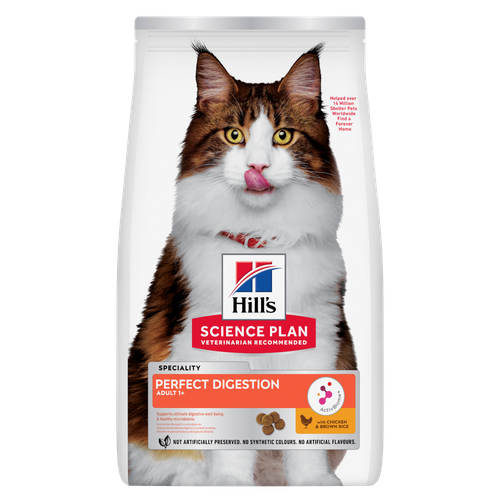
Hill's Science Plan Perfect Digestion Cat Food with Chicken & Brown Rice nourishes your cat's unique microbiome and helps them reach their full potential.
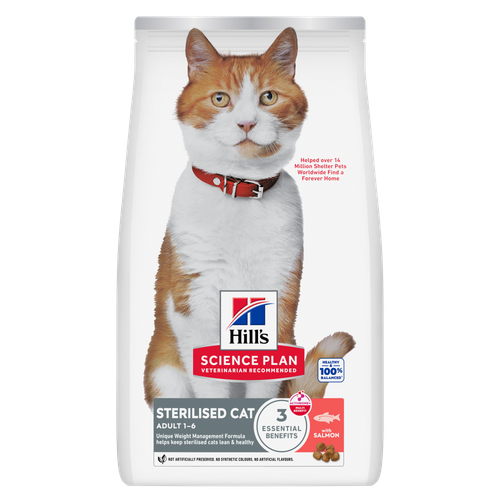
Hill's Science Plan Adult Sterilised Cat Dry Food with Salmon is specially formulated with ActivBiome+ Multi-Benefit Technology. It is a precisely balanced nutrition, tailored to meet the needs of sterilised cats, to help keep them lean & healthy.
Related articles

From essential vitamins & minerals to different types of meat, learn what to look for when choosing the best cat food for your feline.

Learn how to make homemade cat treats that are healthy for your pet with this recipe from Hills Pet Nutrition.

There are three common ways to feed a cat. Each way has its advantages and disadvantages.

Chocolate is known to be poisonous for dogs, but it can also be toxic for cats. Learn why chocolate is bad for cats & what to do if she's eaten it.

Put your cat on a diet without them knowing
Our low calorie formula helps you control your cat's weight. It's packed with high-quality protein for building lean muscles, and made with purposeful ingredients for a flavourful, nutritious meal. Clinically proven antioxidants, Vitamin C+E, help promote a healthy immune system.
Put your cat on a diet without them knowing
Our low calorie formula helps you control your cat's weight. It's packed with high-quality protein for building lean muscles, and made with purposeful ingredients for a flavourful, nutritious meal. Clinically proven antioxidants, Vitamin C+E, help promote a healthy immune system.

